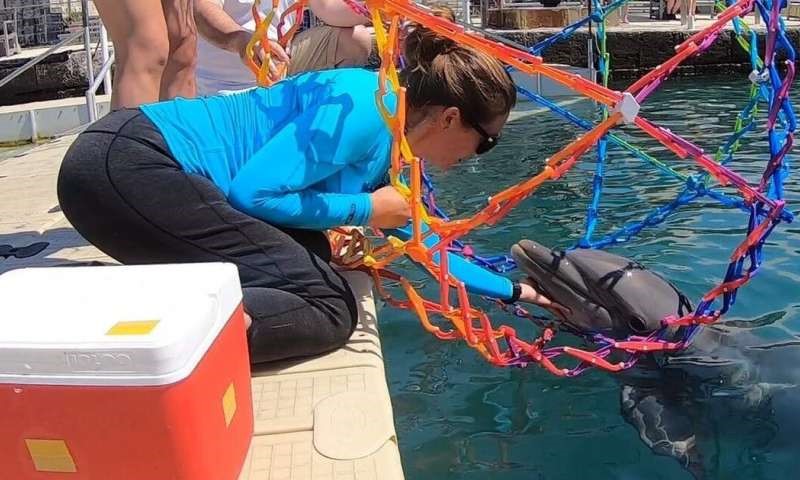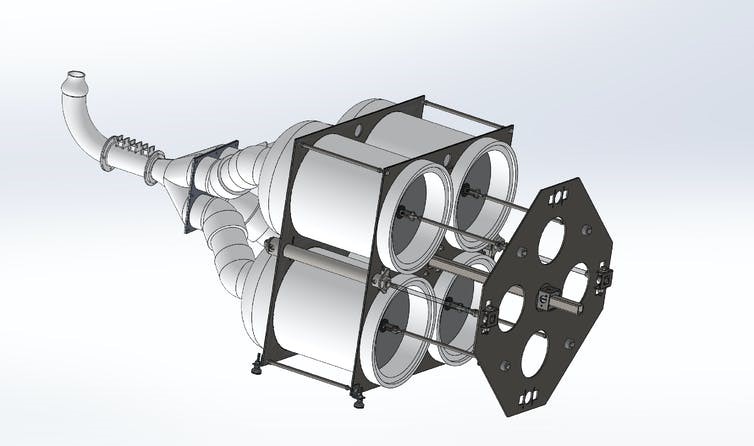Less Invasive Technology For Studying Dolphins In The Wild

Researchers have found changes in stress levels and also reproductive health in whales and dolphins, however, this information is hard to collect. Teaching Assistant Professor at Oklahoma State University, Jason Bruck, wants to understand just how much influence people have on the overall health of dolphins. He and his colleagues are currently creating a type of drone that can collect samples from the spray that comes from the dolphins’ blowholes (Bruck 2020).
Normally, when a researcher wants to measure a dolphin’s overall health, they will use either remote biopsy darting, or simply handling the dolphin to collect the data that they need. Remote biopsy darting typically consists of researchers using a crossbow to shoot a small dart in the side or the back of the dolphin or whale, which penetrates the skin and takes out a small sample of skin and blubber. The dart pops out of the animal and has a float attached to the end to make it easily retrievable. Neither of these methods necessarily hurt the dolphins, however, it is suspected that they can increase stress levels, as they are more invasive techniques (Ewald 2020).

Bruck’s idea is to create a drone that would improve the way researchers take samples by being less stressful to the dolphins and also less challenging and less expensive for the researchers. His plan is to make a quiet drone that will fly into a dolphin’s blind spot, so as not to bother them, and collect samples from the spray that shoots out from the blowhole, which is mucus mixed with seawater, called the blow. Hormones can be found in the mucus when researchers sample the blow, including cortisol, which indicates the stress levels, and progesterone, which indicates the reproductive ability, and together can help determine the overall health of the dolphin (Bruck 2020).
There are researchers who have already used drones to collect blow samples from whales, however, whales have bigger blows and therefore send more droplets into the air and for a longer period of time. They also don’t startle as easily as the dolphins (Thompson 2014). Therefore, collecting blow samples from whales is an easier task than collecting from dolphins
Before Bruck could build a drone to collect this data, he needed more information about their hearing and their sight. He and his colleagues worked in dolphin facilities including the Dolphin Quest in Bermuda. The Dolphin Quest primarily teaches guests about dolphins, but it also allows researchers to use the dolphins for noninvasive research.
Bruck and his team wanted to know exactly what the dolphins could hear and what they could see around their heads, including where their blind spots were. To test the dolphins’ hearing, they played drone noise in the air and recorded the dolphin’s behavior. They took note of how many dolphins looked at the speaker and they used this information to determine how well they could hear. To test the dolphins’ sight, they placed lights inside an expandable sphere, called the Hobermann sphere. The lights were able to be turned on and off and the dolphins were trained to whistle when a light was turned on. The researchers turned lights on one at a time and because of this, they were able to map out the dolphins’ field of view (Bruck 2020).

They also needed to understand the blow better, so they created a robodolphin which replicates a dolphin lung and its blowhole. To build this, they worked with dolphins who were able to sneeze on command and they measured the blow. With photography and a 3-D printer, they were able to have the robodolphin’s spray be almost identical to a real dolphins spray. The robodolphin could show the researchers how close they needed to be in order to get the blow samples and also how quiet the drone needed to be, so as not to disturb the dolphins (Bruck 2020).


Bruck and his team will test drones on the robodolphin for practice and they will also test to make sure the drones can successfully catch and hold the hormones. If these steps are successful, they will use the drones on resident dolphins, as they live closer to the shorelines and are already accustomed to boat noise (Bruck 2020).
The collection of these samples from the dolphins’ blowholes is still a long way off from now, but it is a big step in possibly lowering the stress levels of dolphins, as well as being a cheaper, and easier alternative for researchers to study dolphins’ health.
–Kylee Enders, Intern at Cape May Whale Watch and Research Center
Stockton University
Works Cited
Bruck, J. (2020). Researchers Building a Specialized Drone to Study Dolphins in the Wild. The Conversation. Retreived August 16, 2020, from https://phys.org/news/2020-07-specialized-drone-dolphins-wild.html
Thompson, L.A., Spoon, T.R., Goertz, C.E.C., Hobbs, R.C., Romano, T.A. (2014). Blow Collection as a Non-Invasive Method for Measuring Cortisol in the Beluga (Delphinapterus leucas). Plos One. Retrieved August 16, 2020, from https://journals.plos.org/plosone/article/file?id=10.1371/journal.pone.0114062&type=printable
Ewald, M. (2020). Sharpshooting for Science: Studying Whales with Remote Biopsy. The Maritime Executive. Retrieved August 16, 2020, from https://maritime-executive.com/editorials/sharpshooting-for-science-studying-whales-with-remote-biopsy
